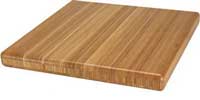Cutting Boards
| Home |

Why use a cutting board?
1. Cutting boards protect your expensive counter top from damage resulting from the sharp edge of the kitchen knife.
2. They also protect the edge of the knife from damage from the counter top (at least in the example of a wood cutting board).
3. They can be used to handily move the chopped or cut food to a skillet or pot, keeping most of the mess in a small easy to clean area.
4. They can be easily cleaned and disinfected in the kitchen sink.
What kind of cutting boards are available?
The most common and popular cutting boards fall into two groups;
1. Plastic
2. Wood
What are the advantages and disadvantages of the different type boards?
1. Plastic boards are; lightweight, inexpensive, and not quite as prone to staining as wood. Disadvantages are, they easily cut and nick, they will soon destroy your knife's sharp edge, and can readily harbor bacteria once nicked and scuffed.
2. Wood - very edge friendly, will not unduly dull your knife's sharp edge. Wood has a porous structure with a unique wicking action that will actually kill surface bacteria by removing the moisture from the surface. Disadvantages are they require more maintenance, should not be put in the dishwasher nor soaked in water, they are heavier, and more expensive than plastic.
Which to use, Wood or Plastic?
Cutting Boards have been the subject of much debate when it comes to cleanliness and infection prevention. We have researched several articles on the relative safety of wood versus plastic boards. The one conclusion that we see over and over (in current research) is that they are both safe if cleaned regularly and properly. If they are both safe and you the user take the time to clean and properly disinfect the board, then it is our opinion to opt for the wood boards because they do not destroy the edge of your knives like many hard plastic boards will very quickly do.
Also it is a very good idea to have more than one board, one exclusively for vegetables and one specifically for meats. Two boards help prevent cross contamination of the raw meat preparation with the vegetables and salad. Two cutting boards is one more way to keep the meal safe from bacterial contamination.
How does one sanitize cutting boards?
The one universally agreed upon method of cleaning and sanitizing both wood and plastic boards is as follows. First a thorough scrubbing with warm soapy water - be sure to remove all food particles, oils, grease, and residue. Secondly a mixture of water and bleach solution (one tablespoon of liquid chlorine bleach in one gallon of water) to completely disinfect the surface area all around. Thirdly and importantly let the board completely dry.